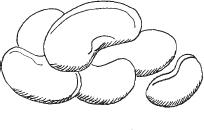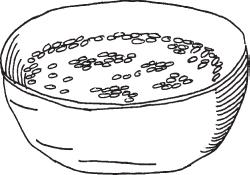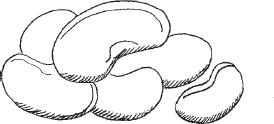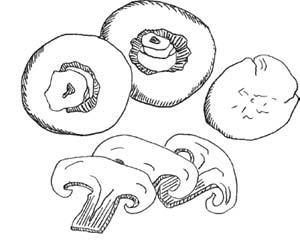Nourishing Traditions: The Cookbook That Challenges Politically Correct Nutrition and The... (108 page)
Authors: Sally Fallon,Pat Connolly,Phd. Mary G. Enig
Tags: #Non-Fiction, #Reference, #Science, #Health
LEEKS
Braised Leeks
Serves 6
Trim ends off leeks and split lengthwise. Rinse well and set in a pyrex pan. Bring beef stock to a boil and pour over leeks. Bake at 350 degrees for about ½ hour or until stock has reduced and leeks are tender. Sprinkle on cheese and melt under broiler for a few minutes. Serve immediately.
Leeks were once the staple vegetable of Europe. Unfortunately, this fine root fell from favor in the 17th century, along with onions and garlic and any food that would "taint the breath." In recent years, leeks have made something of a comeback. They can always be used in place of onions although they have a slightly more pungent flavor than their bulbous cousins. Leeks are good sources of carotenoids, B complex and vitamin C and are considered salutary for the liver.
Buy leeks that have not been trimmed as the leaves are your indication of freshness. Both the white part and the green should be used.
Leeks are often gritty, and it is important to clean them well. To clean leeks, cut off end, remove outer leaf and slit lengthwise into the center. Open up and clean all layers under running water. SWF
Vegetable Leek Medley
Serves 6
2 medium leeks
2 zucchini
2 carrots
1 red pepper
4 tablespoons butter
sea salt and pepper
The secret of this attractive dish is proper preparation—the vegetables should be cut into small and uniform pieces. Cutting can be done in advance, and the dish prepared just before your meal.
Clean leeks, slice crosswise at ¼-inch intervals and set side. Cut ends off zucchini and make thick peelings of the skin. Cut the skin into a fine julienne and set aside. (Use the inner part for soups.) Peel the carrots and cut into a fine julienne. Seed the pepper and cut into thin, 1-inch strips.
Saute carrots and leeks in butter. When they are just tender, add the pepper and cook about 1 minute. Finally, add zucchini and saute another minute. Season to taste.
Every new concept developed in medical science points the way to a new area awaiting further exploration. Discarding both the use of drugs and the germ theory of disease opened the way for me to explore new methods of eliminating the stagnating waste products from the body. Briefly stated my position is: improper foods cause disease; proper foods cure disease. In upholding this theses, I have been in disagreement, at times sharp, with organized orthodox medicine. Henry Bieler, MD
Food Is Your Best Medicine

LIMA BEANS
Plunge freshly hulled or frozen lima beans in boiling filtered water and cook about 8 minutes or until tender. Drain in a colander and transfer to a heated serving dish. Toss with butter and season to taste with sea salt and pepper. You may want to first melt the butter and add to it one or two mashed garlic cloves.
Lima beans are one of the few beans that are eaten both dried, as a legume, and fresh, as a vegetable. They grow well in hot climates.
Lima beans contain B complex vitamins, iron, potassium and phosphorus and a fair amount of protein. They contain more starch and less fat than most beans.
If you grow your own lima beans, you will be able to enjoy them freshly hulled. Avoid the hulled lima beans that sometimes appear in supermarkets and gourmet shops—these are usually dosed with preservatives. If you do not have a garden, your best bet is frozen lima beans, only slightly inferior, nutritionally speaking, to freshly hulled beans. SWF
Simple Succotash
Serves 62 cups shelled lima beans
6 ears corn, cut off the cob
4 tablespoons butter
½ cup
piima cream
or
creme fraiche½ cup
chicken stocksea salt and pepper
Succotash comes from the Narragansett Indian word "misick-quatash," meaning "ear of corn." Indian succotash consisted of beans, corn kernels, dog meat and bear grease. The succotash that finds its way to American tables has a slightly different list of ingredients.
Saute corn in butter until just tender. Add lima beans, cream and stock. Bring to a boil and skim. Simmer, uncovered, until the liquid has reduced and beans are tender. Season to taste. Succotash should be soupy, not too thick, and it is served in bowls.
Gourmet Succotash
Serves 8-12
2 cups shelled lima beans
6 ears of corn, cut off the cob
2 cups french beans, cut into 1-inch pieces
4 tablespoons butter
1 bunch green onions, chopped
1 red pepper, chopped
1 cup
piima cream
or
creme fraiche1 cup
chicken stocksea salt and pepper
Saute onion and pepper in butter. Add remaining ingredients, bring to a boil and skim. Simmer, uncovered, for about 10 minutes or until beans are tender. Season to taste and ladle into heated serving bowls.

Dr. William A. Albrecht, the famous soil specialist, reminds us that plants will make a lot of growth, just as you and I will, even when certain wanted minerals are missing. But the plants themselves will be different. Thus, cabbage is one thing if grown on one kind of soil, another if grown on another kind of soil. There are more minerals in it, or less, depending on the minerals in the soil; and, apparently, more or less proteins and vitamins in it. The same is true of carrots, beets, peas, oranges, apples, potatoes, sweet corn or any other plant product we use as food. The calcium concentration of a lettuce leaf can be varied twofold and spinach threefold, according to the calcium in the soil. . .the same mineral variations occur in grasses and other plants eaten by domestic animals; and what they eat, in turn, affects their products which we eat. Our beefsteaks, pork chops, lamb roasts and omelets can be mineral-shy if the cows, hogs, lambs and chickens were shortchanged on their minerals. "Are We Starving To Death?"
The Saturday Evening Post 1945

MUSHROOMS
Mushrooms must be very fresh or they are not worth cooking. Remove stems, wash well and, most importantly, dry well. They can now be sauteed in olive oil and butter either whole, quartered or in slices. To saute whole, melt butter and olive oil until it froths. Place mushrooms top side down in pan. When this side is golden, turn to other side. Saute another minute and transfer to heated platter or serving dish. Saute sliced or quartered mushrooms in small batches or they will not brown.
Mushrooms belong to the fungus family, one of the most primitive of all plant groups. Actually, the mushroom is the fruit of the fungus, which grows underground. Mushrooms contain over 90 percent water and thus act as sponges, absorbing the flavors of other foods with which they are cooked. They contain protein, phosphorus, potassium, calcium, iron and B complex vitamins, particularly biotin. Mushrooms are also rich in selenium, necessary for a healthy heart and circulatory system. Certain varieties of mushroom have long been valued for their medicinal properties in the Orient, and in recent years the Japanese have done some interesting research in this area. A substance called adenosine has been isolated from the tree-ear mushroom; it has potent blood thinning and anticoagulating properties. Just a small amount of black tree-ear mushroom can have a profound effect on reducing blood stickiness, clots and plaque buildup. Other commercially available mushrooms that seem to have these positive effects on the blood include the shiitake, enoki and oyster mushrooms. These mushrooms may also have anticancer properties. Other commercially grown mushrooms seem to be devoid of specific pharmacological effects, but they are still valuable in the diet for their trace mineral and B vitamin profile. SWF

ONIONS
This versatile vegetable is usually used in conjunction with other vegetables, but it also performs well on its own.
Onion Compote
Serves 66 large onions, peeled and thinly sliced
4 tablespoons butter
2 tablespoons extra virgin olive oil
In a heavy skillet, cook onion in butter and olive oil on low heat for 1 hour or more, stirring occasionally. Onions will turn light brown and develop a caramel taste. This is delicious with
rib roast
.